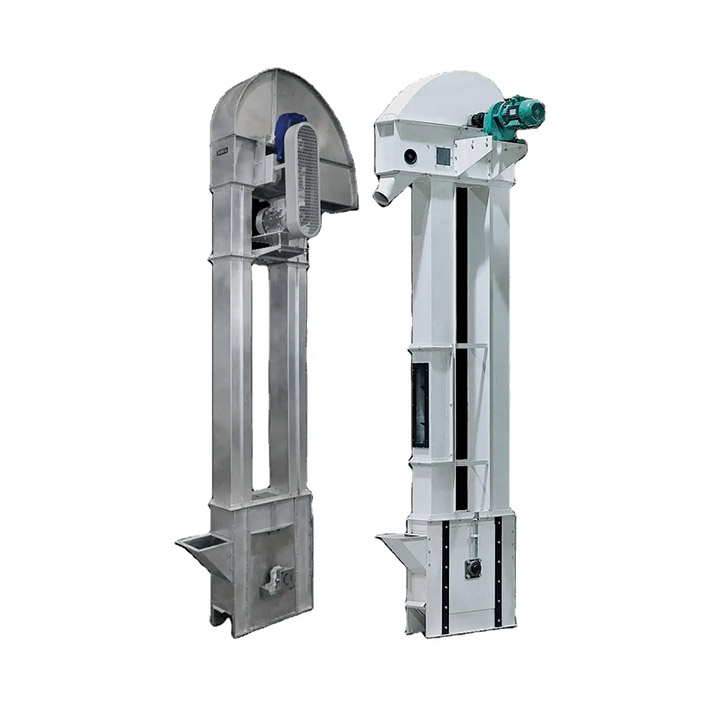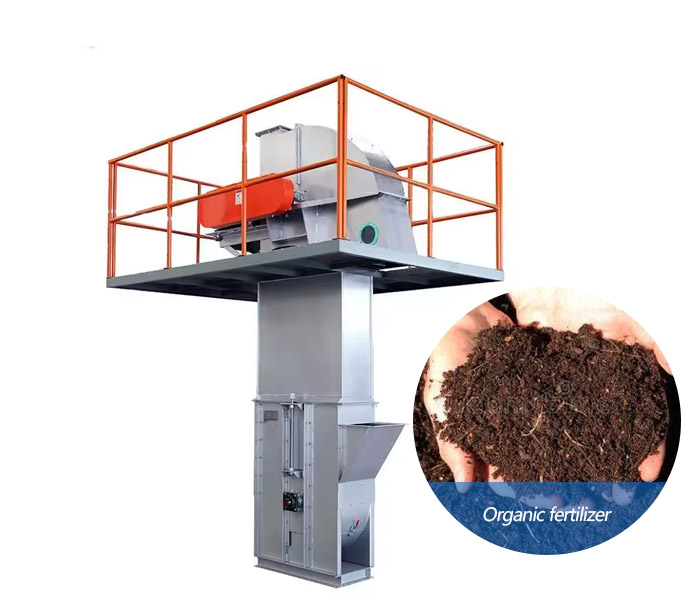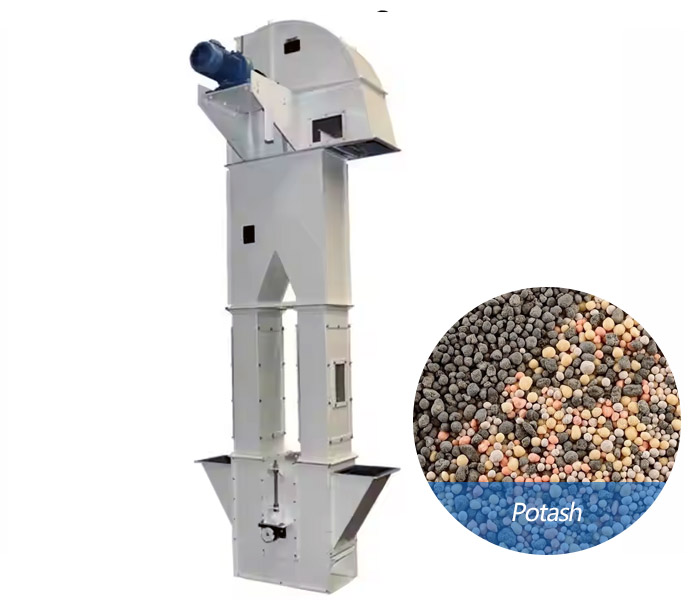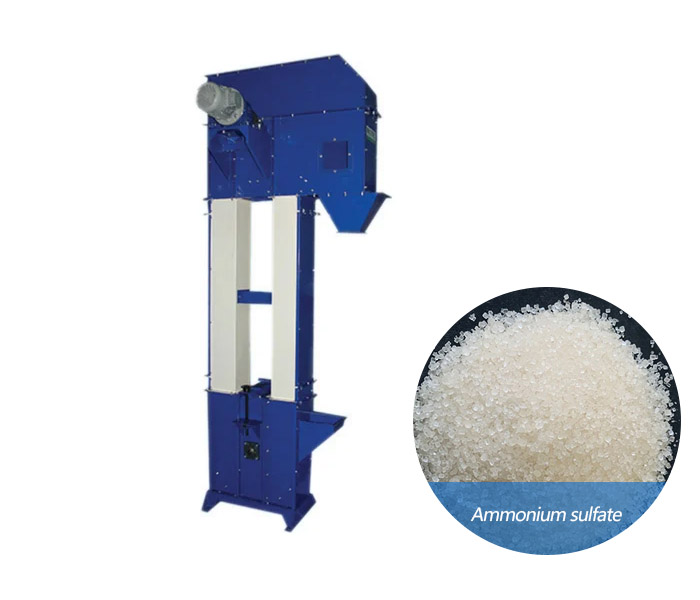
Ammonium sulfate bucket elevator
Vertical or inclined conveying of ammonium sulfate is widely used in fertilizer, chemical, pharmaceutical and other industries
| Lifting height | 10-80 meters, customized according to specific needs. |
| Conveying capacity | 10-100t/h |
| Hopper capacity | 0.5-50 L |
| Motor power | 3-7.5 kW |
| Material | carbon steel, stainless steel, etc. |
| Bucket | Q-type (light bucket), H-type (arc bottom bucket), Zd-type (middle deep bucket), and Sd-type (deep bucket) |
What is Ammonium Sulfate Bucket Elevator?
Ammonium Sulfate Bucket Elevator is a mechanical equipment specially used for conveying ammonium sulfate vertically or obliquely. Ammonium sulfate is an important inorganic salt. Due to its granular or powdered physical properties, bucket elevator is an ideal choice for conveying ammonium sulfate. It uses a series of buckets fixed on chains or belts to efficiently and stably lift ammonium sulfate upward continuously, which not only improves production efficiency, but also solves problems such as dust pollution and equipment corrosion, creating significant economic benefits for customers.
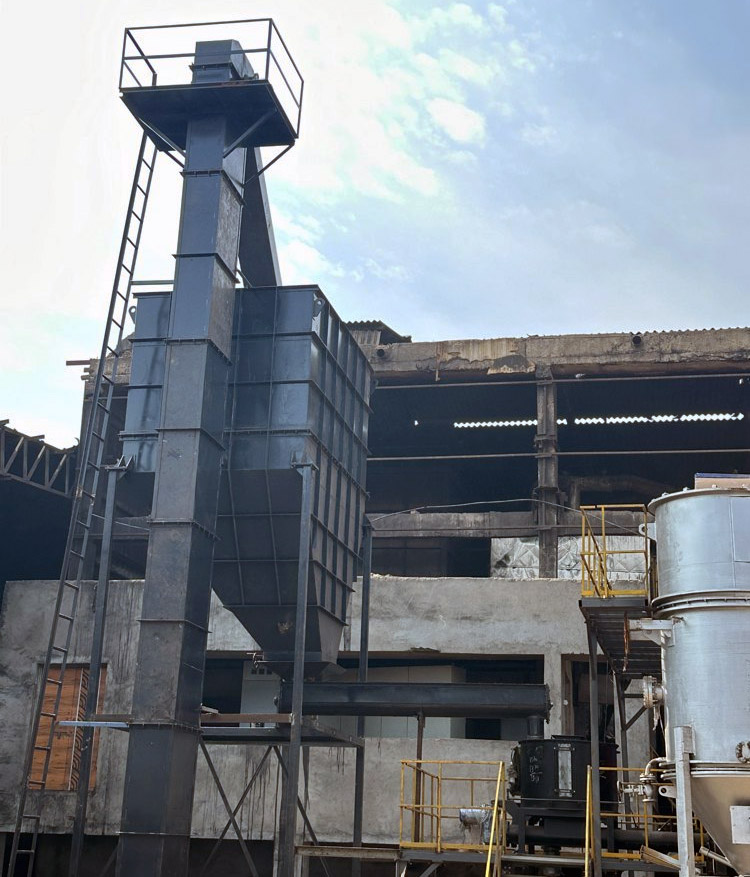
Why use Bucket Elevator to convey Ammonium Sulfate?
1. Efficient vertical conveying
Ammonium sulfate usually needs to be conveyed from low to high, such as from warehouse to reactor or packaging line. Bucket elevator can efficiently and continuously complete vertical or oblique conveying tasks, which is suitable for large-scale production needs of ammonium sulfate.
2. Closed design to prevent dust pollution
Ammonium sulfate is prone to dust during transportation. The closed structure of the bucket elevator can effectively prevent dust from overflowing, reduce material loss, and protect the working environment and the health of operators.
3. Adapt to granular and powder characteristics
Ammonium sulfate may be granular or powdery. The bucket elevator's bucket design can adapt well to these two forms to ensure that the material will not spill or clog during transportation.
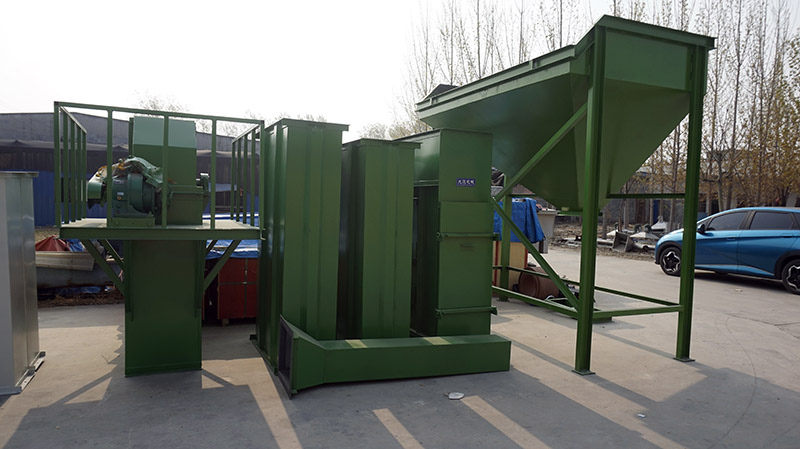
4. Corrosion resistance
Ammonium sulfate has a certain degree of corrosiveness. The bucket elevator can be made of stainless steel or other corrosion-resistant materials to ensure that the equipment is not affected by corrosion during long-term use and extend its service life.
5. High degree of automation
The bucket elevator can be seamlessly connected with other equipment in the production line (such as conveyor belts, packaging machines, etc.) to achieve automated operation and improve production efficiency.
6. Low energy consumption and stable operation
The bucket elevator has a simple structure, stable operation, low energy consumption, and is suitable for long-term continuous work to meet the high-intensity requirements of ammonium sulfate production.
7. Easy to maintain
The design of the bucket elevator is convenient for daily maintenance and cleaning, reducing downtime and improving production efficiency.
What are the applications of ammonium sulfate bucket elevator?
Ammonium Sulfate Bucket Elevator can be used to convey powder, granules, small blocks and non-abrasive and semi-abrasive materials such as coal, coke, cement, sand, crushed ore, etc.

In fertilizer production, it is used to lift ammonium sulfate crystals or particles.
In the chemical industry, it is used to lift chemicals such as ammonium sulfate.
Used in other industrial occasions where vertical conveying of bulk materials is required.
How does the ammonium sulfate bucket elevator work?
When the Ammonium Sulfate Bucket Elevator is working, the ammonium sulfate material enters the bottom of the elevator through the feed port; the hopper, driven by the chain or belt, lifts the material from the bottom to the top; at the top, the hopper dumps and discharges the material through the discharge port.
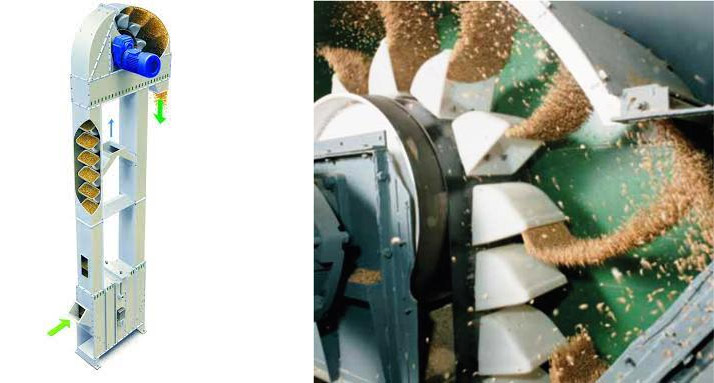
Ammonium Sulfate Bucket Elevator Parameters
| Model | Max feed size(mm) | Capacity(T/H) | Lifting speed(m/s) | Belt width(mm) | Lifting height(m) |
| TD160 | 25 | 5.4-16 | 1.4 | 200 | <40 |
| TD250 | 35 | 12-35 | 1.6 | 300 | |
| TD315 | 45 | 17-40 | 1.6 | 400 | |
| TD400 | 55 | 24-66 | 1.8 | 500 | |
| TD500 | 60 | 38-92 | 1.8 | 600 | |
| TD600 | 70 | 85-142 | 2 | 700 |
What structures does the Ammonium Sulfate Bucket Elevator consist of?
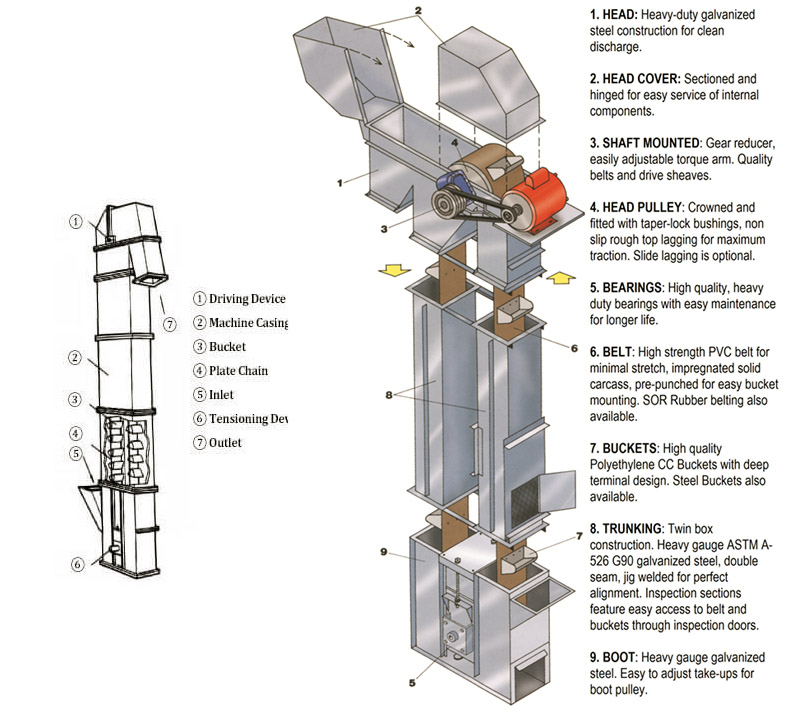
Hopper: used to carry ammonium sulfate, designed as a deep bucket, shallow bucket or sharp bucket according to the material characteristics.
Drive device: includes motor, reducer and transmission chain (or belt) to provide power.
Housing: closed structure to prevent dust from spilling and protect the environment.
Feed inlet and discharge outlet: located at the bottom and top of the equipment respectively, used to receive and unload ammonium sulfate.
Tensioning device: used to adjust the tightness of the chain or belt to ensure stable operation of the equipment.
Inspection door: convenient for equipment maintenance and troubleshooting.
Ammonium Sulfate Bucket Elevator Case
Case 1: Fertilizer production enterprise
A fertilizer production enterprise needs to transport ammonium sulfate from the warehouse to the packaging line. The traditional conveying equipment is inefficient and has serious dust pollution. After the introduction of the ammonium sulfate bucket elevator, the production efficiency increased by 30%, the dust problem was effectively controlled, the equipment operated stably, and the maintenance cost was significantly reduced.
Case 2: Chemical raw material supplier
A chemical raw material supplier needs to transport ammonium sulfate from the reactor to the storage silo during the production process. Since ammonium sulfate is corrosive, ordinary equipment is easily damaged. After using the ammonium sulfate bucket elevator made of corrosion-resistant materials, the service life of the equipment is extended by 50%, and automatic transportation is realized, reducing labor costs.
Case 3: Pharmaceutical Company
A pharmaceutical company uses ammonium sulfate as a raw material and needs to transport it from the warehouse to the production line. Due to the high cleanliness requirements of the production environment, traditional conveying equipment cannot meet the needs. The closed design of the ammonium sulfate bucket elevator effectively solves the dust problem, ensures the cleanliness of the production environment, and improves the conveying efficiency.
| Application scenario | Lift height | Lifting capacity |
| A medium-sized compound fertilizer production enterprise needs to vertically lift the semi-finished granular ammonium sulfate after drying and cooling from the lower conveyor belt outlet to the higher finished product screening machine entrance for subsequent particle size classification and packaging. | 18 meters | 25 tons/hour |
| In a large Indian chemical group, in its raw material processing area, it needs to quickly lift the purchased crystalline ammonium sulfate raw materials unloaded by trucks or trains into the pit receiving hopper to the top of the raw material silo as high as tens of meters for storage for subsequent production lines. | 35 meters | 80 tons/hour |
| A thermal power plant or industrial boiler enterprise in Vietnam lifts the wet crystallized/dried powdered ammonium sulfate treated in the collection tank or concentration equipment to a temporary storage silo or loading system. | 12 meters | 10 tons/hour |
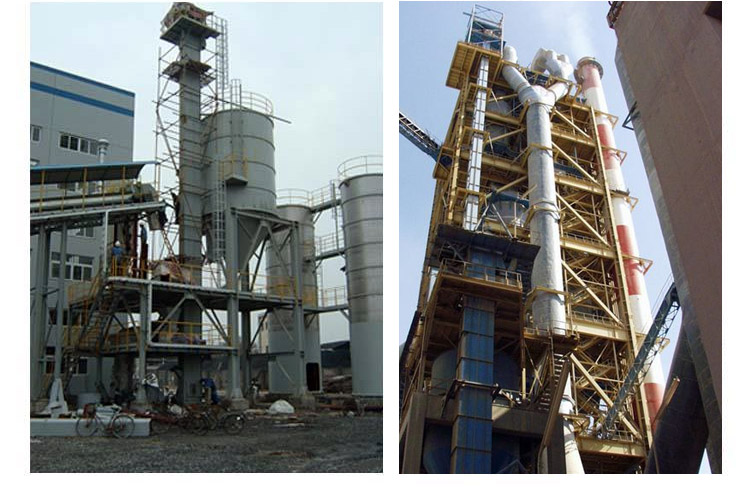
How to select an Ammonium sulfate bucket elevator?
1. Select according to material characteristics
Ammonium sulfate is corrosive, easy to absorb moisture, and easy to agglomerate. The selection needs to consider:
Material selection: 304/316 stainless steel or carbon steel + anti-corrosion coating is recommended to prevent corrosion
Bucket design: deep bucket or shallow bucket (select according to particle size) to ensure smooth material unloading
Sealing: fully enclosed structure to prevent moisture absorption, agglomeration and dust overflow
2. Determine the lifting capacity (Capacity, TPH)
Small-scale production line: 10-50 TPH (suitable for packaging workshop)
Medium-sized fertilizer plant: 50-200 TPH (common in compound fertilizer production)
Large chemical storage: 200-500 TPH (suitable for port/silo loading and unloading)
3. Lifting height (Lift Height)
Internal transportation in the workshop: 5-15 meters (such as batching system)
Transportation across the factory floor: 15-30 meters (such as raw material warehouse to production line)
Large storage loading and unloading: 30-50 meters (such as silo to loading system)
4. Other key selection factors
Drive mode: belt drive (low noise, suitable for light load); chain drive (high durability, suitable for heavy load/corrosive environment)
Safety configuration: explosion-proof motor (essential for chemical industry area); speed monitoring and overload protection
